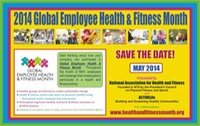After attending the "Inactivity in America: A Looming Public Health Crisis" event last week and then reading about a new childhood obesity "advocacy" initiative, I wrote to a few colleagues to express some optimism at what I see as a dramatic shift in the attitudes of the health and fitness industry leadership.
This is the letter I sent, slightly modified to include some links:
Dear Friend and Leader:
Here's a "lightening bolt." The Robert Wood Johnson Foundation and the American Heart Association are teaming up to the tune of $8 million to "advocate" for programs and policies to reverse childhood obesity. See the article that follows this message.
I remember the first Be Active America advocacy training program held here in DC in about 1989 at the Capital Hyatt Hotel. About 100 top leaders were invited and BAA footed the bill for all the speakers, travel, etc. RWJF, AAHPERD, and ACSM all explained there was insufficient data to warrant action of this nature. Besides, nonprofits, by law, cannot lobby. BAA countered by trying to explain that advocacy and lobbying were two different matters and that advocacy for a healthy nation was a moral obligation of health and fitness professionals.
We went on to explain why public information campaigns and "special PR events" did next to nothing to facilitate grassroots change. To back it up, we brought in Michael Pertschuk (one of my workout buddies at the time) who was Director of the U.S. Dept. of Consumer Affairs. He told those gathered that without an sound advocacy agenda, their issues will go ignored and unattended.
The crowd shuffled out the door in silence, into the mist of confusion and back to business as usual.
In this past week, two events have taken place that may indicate that the corpse of professional health and fitness groups still has a heart beat. First, a remarkable meeting held last Thursday in the nation's capitol at the Newseum's Knight conference center. It was led by ACSM and co-hosted by George Mason University and the Center for Health and Risk Communications.
Without going into all the details, there was a remarkable shift in the conversation and the usual ACSM spokespersons (Russ Pate, Steve Blair and Jim Whitehead) carried the bacon. To make it short, I was total impressed by their apparent 180 degree switch in recognizing the failure of our profession to get engaged in advocacy strategies and programs at the state and federal levels. It felt like a space ship had just landed and, while those disembarking looked familiar, they were speaking in an entirely different language.
I was particularly impressed by what Russ Pate and Jim Whitehead said, and the energy behind their voices. When I commended one of the leaders, noting their "radical switch into the real world," he responded with a small compliment: "You guys were just ahead of your time." Time will tell if they intend to reinvent the wheel or are ready to "suit-up" and get on the field of play. Stay tuned.
Perhaps another sign of positive change can be found in the Robert Wood Johnson Foundation (RWJF) announcement mentioned above. Another 180-degree turnaround. This is the outfit that support CDC's "VERB" campaign of several years ago, which was one of the most colossal phony programs in the history of health promotion in my opinion. Led by CDC and funded by RWJF, the program was based upon the display of action verbs with large banners and TV/radio ads. Such things as "Jump," "Run," "Walk," etc. were suppose to get kids off their duffs. (I'm not making this up.). Led by Dr. Michael McGinnis, former HHS Director of Health Promotion and Disease Prevention, "Let's Move" didn't move anything but the funding.
However, by the tone of the content and message in the RWJF press release, there may be hope.
On a cautionary note, Be Active America issues three major points here:
- Invite and embrace those who have been engaged in physical education and fitness advocacy for decades, so as not to reinvent the wheel;
- Remember permanent change is impossible unless the change begins at the grassroots;
- While advocacy must be based upon sound science, science is just our ticket to get on the playing field. To really change direction requires leadership training in communications, governmental relations and coalition building. We must go outside our comfort zone and engage other sectors of our society. At the top of the list is the private sector.
